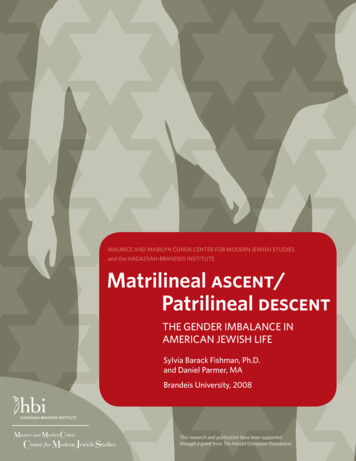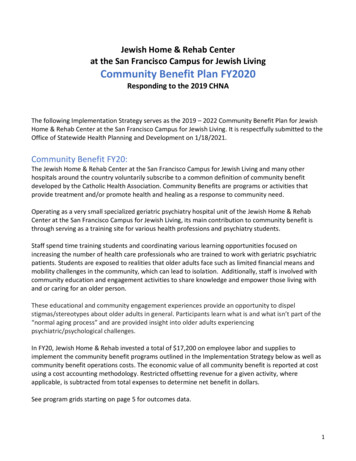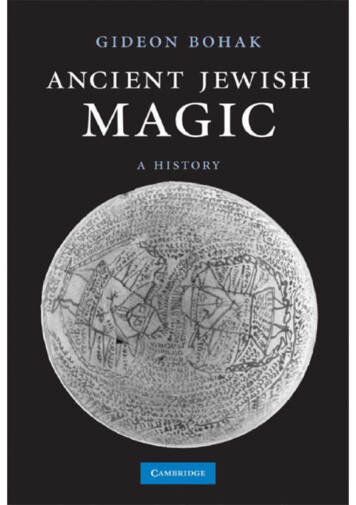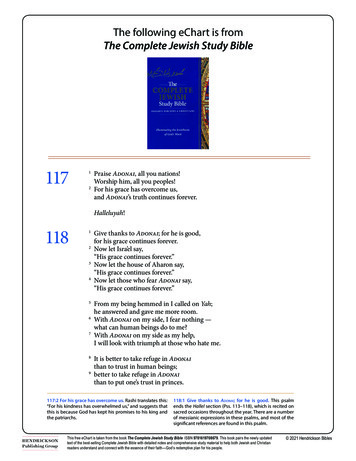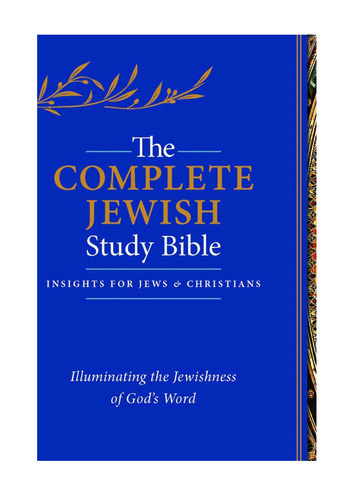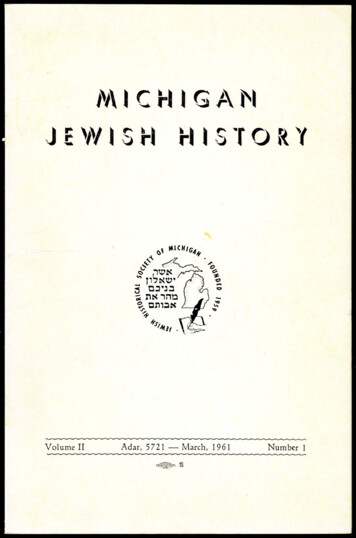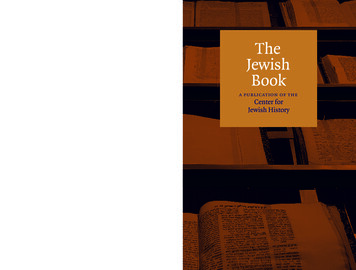
Transcription
the jewish bookTheJewishBooka publication of theCenter forJewish Historycenter for jewish history15 west 16th streetnew york, ny 10011www.cjh.org
This project is made possible bythe generous support of Amy P. Goldmanand is presented by theLillian Goldman Scholars Working Groupon the Jewish Book.
TheJewishBookpublished on the occasion ofthe 10th anniversaryof thecenter for jewish historyat the opening of“the jewish book:past, present, future”the lillian goldman symposiumapril 3, 2011
contentsadam shearThe Jewish Book: Views & Questions4lawrence h. schiffmanThe Dead Sea Scrolls & The History of the Jewish Book12yaacob dweckWhat Is a Jewish Book?24jeffrey shandlerThe Jewish Book & Beyond in Modern Times36Reprinted by permission ofCambridge University Press fromAJS ReviewThe Journal of the Association of Jewish StudiesVolume 34, No.2, November 2010.
TheJewishBook:ViewsandQuestionsAdam ShearAJS Review 34:2 (November 2010), 353–357 Association for Jewish Studies 2010doi:10.1017/S0364009410000371In the last several decades, the studyof reading, writing, and publishing has emerged as a lively field of inquiryin the humanities and social sciences. Historians and literary scholars haveengaged with a number of questions about the impact of changes in technology on reading practices and particularly on the relationship betweennew technologies of reading and writing and social, religious, and political change. The new field of the “history of the book,” merging aspects ofsocial and intellectual history with the tools of analytical and descriptivebibliography, came to the fore in the second half of the twentieth centuryat the same time that the emergence of new forms of electronic mediaraised many questions for social scientists about the ways that technological change have affected aspects of human communication in our time.Meanwhile, while the field of book history emerged initially among earlymodernists interested in the impact of printing technology, the issuesraised regarding authorship, publication, relations between orality and thewritten word, dissemination, and reception have enriched the study of earlier periods.1The coming of the Internet and electronic books has increased thesaliency and frequency of such discussions. Recent years have seen increasing discussion about fundamental changes in the nature of the “book” andof reading practices. Our sense that we may be living through a revolutionin reading practices, driven by technological change, has led to scholarlyand popular interest in the history of the book. While studies of previousepisodes of changes in reading and writing practices help us to illuminateour own situation, the experience of living through changes in technologyhelps historians rethink the past as well.Issues of textual transmission and bibliography have been fundamentalto modern Jewish studies since the nineteenth century, but until recentlythese studies have generally been seen as philological tools toward “establishing the text” or bibliographical tools for locating texts to serve as evidence in historical or literary study. However, as the general field of the5
the jewish book: views & questionsadam shearhistory of the book and reading has taken off in recent decades, the study ofthe history of Jewish books (or “material texts” more broadly) has attractedincreasing attention from scholars in various disciplines across Jewishstudies.In the last decade, we have seen increasing institutional efforts withinthe framework of academic Jewish studies. For a number of years, theCenter for Religion and Media at New York University has sponsored aworking group on Jews and media.2 Since 2003, the Jewish Studies program at the University of Pennsylvania has sponsored a series of annual“master class” workshops on Jewish book history; 3 and in 2005–2006,the Katz Center for Advanced Judaic Studies devoted a year of study to thetopic;4 a new journal on the Jewish book, Quntres, has been founded recentlyunder the auspices of the Jewish Theological Seminary; the venerable AleiSefer has been revived at Bar-Ilan University;5 and conferences and panelson the topic have multiplied in recent years.6Despite these institutional efforts to advance the field and the recentgrowth of publications especially on the impact of print in early modernJewish culture,7 many questions remain about the role of books and reading in Jewish history and about the effects of technological change onJewish culture. During the academic year 2009–2010, the Center for JewishHistory in New York gathered a small number of scholars, at various careerstages, working on different periods in Jewish history and representing arange of methodologies and disciplines, to convene a Working Group onthe History of the Jewish Book. The first task was to consider the “state ofthe field”—or even more fundamentally, the definition of the “field”—inorder to lay out an agenda of questions and topics for discussion. To thatend, we invited Lawrence Schiffman, Yaacob Dweck, and Jeffrey Shandlerto present brief remarks at the opening meeting of the group in October2009. The essays that follow represent only slightly edited versions of thosetalks.8Taken together, the three essays suggest a rough outline of issues forconsideration of the “Jewish book” across different periods and historical contexts. Looking at three distinct periods in Jewish history—the lateSecond Temple period (Schiffman), the early modern age (Dweck), andthe modern and contemporary period (Shandler)—all three essays focuson questions of authorship, publication, dissemination, and readership.9While none of the authors here invokes this model or adheres strictly toit, Robert Darnton’s concept of the “communications circuit” remains auseful heuristic or framing device for understanding the travels of a text inmaterial form from author to reader.10 With attention to storage and collection, our authors also consider the transmission of material texts over time,addressing a central concern of those who noted the relatively synchronicnature of Darnton’s model.11 And all three essays respond to Dweck’s suggestion that the history of the book not only tells us something about theuse of material texts but also serves as an avenue toward discussion ofbroader historiographical concerns. The new model of book history doesnot rigidly mark separations between bibliography, philology, and literaryanalysis. An understanding of the dynamics of print in the production ofthe Shulh.an ’arukh tells us something about the intellectual and religioushistory of early modern Jews; we understand the content of the Dead SeaScrolls better for understanding the scribal practices that created them;and we can appreciate the significance of the emergence of new forms ofJewish literary activity in the modern world more clearly by appreciatingboth the medium and the message.Conversely, we can clearly see some of the challenges for scholars whowant to make use of book history in their methodological toolkit. BothShandler and Dweck emphasize the transformative nature of new technologies in making information more widely accessible and with new formsof “content” found in the new media.12 Of course, in both the early modern and the contemporary cases, we must also try to distinguish betweenthe results of technology and the results of other factors (demographic,political, social, or intellectual). In many cases, the two cannot be easilyseparated.In the case of the writers and users of the Dead Sea Scrolls, technologicalchange is not a major issue, although the conceptualization of the properkind of technology for writing (encompassing questions of writing surface,ink, and format) are of concern to some in the Second Temple period and inthe rabbinic literature that emerged later. It would be a mistake, however,67
the jewish book: views & questionsadam shearto assume that change in the technology of publication only matters fromGutenberg forward. While the medieval handwritten book is not addressedin this forum, a scholarly consensus has emerged that the transition fromscroll to codex had a transformative impact in late antiquity in the West.13The full impact of this transition on Jewish culture has not been comprehensively studied, although we do know a great deal about the codicological aspects of medieval Hebrew manuscript books, thanks to the work ofMalachi Beit-Arié, Collette Sirat, and others.14Schiffman’s survey of the different attitudes toward orality and writingby different Jewish groups in late antiquity reminds us that a full pictureof Jewish literary culture in any period must attend not only to the realityof scribal practices and/or practices of oral transmission but also to theideological framing of what a text—specifically, an authoritative text—is.As Schiffman points out, by the beginning of the medieval period, the rabbinic emphasis on “oral Torah” was primarily an ideological frameworkrather than an accurate description of the material form of canonical literature.15 The “textualization of rabbinic culture” (as Talya Fishman puts it)in the Middle Ages certainly needs further study.16 Despite a lack of majortechnological changes in the material forms of Jewish books from approximately the eighth century to the fifteenth, the medievalist is well positionedto consider the processes of writing, publication, dissemination, andreception that Schiffman notes in antiquity and that Dweck and Shandlernote in modernity.17Finally, a word about the rubric Jewish book. All three essays either implicitly or explicitly raise the question of what a “Jewish” book is. Is it a bookwith a Jewish author? An intended Jewish reader? A book written in Hebrewor in a vernacular in Hebrew script? Or is it a book with “Jewish content”?Can the same text (e.g., the Bible) be “Jewish” in some contexts and notin others? Certainly we can dismiss some such questions as semanticquibbling, and get on with the practical business of historical and literaryscholarship. However, a careful consideration of the dynamics of such definitions and interactions in different historical contexts points out someof the ways that book history can illuminate larger historiographical questions. If we reframe the question from “what is a Jewish book” to what canwe learn about perceptions and views of given historical actors in their categorization of particular material texts, we open up a more nuanced historical analysis, attuned more carefully to the complex dynamic interplay oftext and context in any given time and place. We hope that the three essayshere offer food for thought and useful suggestions for agenda-setting forthis complex and dynamic field of scholarly inquiry.89Adam Shearuniversity of pittsburghPittsburgh, Pennsylvania
the jewish book: views & questionsnotes1 On the development of book history,see Leslie Howsam, Old Books and NewHistories: An Orientation to Studies in Bookand Print Culture (Toronto: University ofToronto Press, 2006).2 This group sponsors a Web site (ModiyaProject, http://modiya.nyu.edu/) thatcontains details of their work over theyears.3 Jewish Studies Program at the Universityof Pennsylvania, The Manfred R. LehmanMemorial Master Workshop in theHistory of the Jewish Book, http://ccat.sas.upenn.edu/jwst/lehmann.htm.4 For a list of members of that group andtheir topics of research, see http://www.cjs.upenn.edu/ program/2005-2006/list.html.5 Quntres is available at x.Alei Sefer is available through Bar-IlanUniversity Press at http://www.biupress.co.il/website en/index.asp?category 62.6 For example, the organizers of theEarly Modern Workshop, an annualproject dedicated to translation anddiscussion of primary sources for earlymodern Jewish history, devoted the 2009workshop to the issue of Jewish readingpractices. See “Reading across Cultures:The Jewish Book and Its Readers inthe Early Modern Period,” http://www.earlymodern.org/workshops/2009/.7 Amnon Raz-Krakotzkin, “Print andJewish Cultural Development,” inEncyclopedia of the Renaissance, ed. P.Grendler et al. (New York: CharlesScribner’s Sons, 1999), 3: 344–46;Zeev Gries, The Book in the Jewish World,1700–1900 (London: Littman Libraryof Jewish Civilization, 2007); and most89101112131410recently David B. Ruderman, Early ModernJewry: A New Cultural History (Princeton,NJ: Princeton University Press, 2010),chap. 3, “Knowledge Explosion.” Foradditional references on more specificareas, see the works cited by Dweck in hisessay.I am grateful to Elisheva Carlebach forher support of the Working Group andfor her invitation to submit these essaysto AJS Review.For reasons of time, we were not ableto invite contributions from scholarsworking on the rabbinic period or themedieval period. See below for somecomment on the study of the Jewish bookduring the period in which manuscriptcodices were the primary means of disseminating texts.Robert Darnton, “What Is the Historyof Books?” Deadalus 111 (Summer 1982):65–83.See Thomas R. Adams and NicolasBarker, “A New Model for the Studyof the Book,” in A Potencie of Life: Booksin Society, ed. N. Barker (London: TheBritish Library, 1993), 5–43.My use of the term content here is self-consciously a reminder that our conceptualization of past periods is shaped by ourown time. I doubt very much that I wouldhave characterized the nature of the textsin an early modern printed book usingthe rubric of content before the inventionof the Internet.For a recent study of the importance ofthe codex in the emergence and spreadof Christianity, see Anthony Graftonand Megan Williams, Christianity and theTransformation of the Book (Cambridge,MA: Harvard University Press, 2006).To my knowledge, no comprehensivesurvey of the impact of the scroll-codexadam sheartransition on Jewish culture exists. For asurvey of the existing studies on the earlyHebrew codex, see Stefan C. Reif, “TheImpact on Jewish Studies of a Centuryof Genizah Research,” in Jewish Studiesat the Turn of the Twentieth Century, ed.Judit Tagarona Borrás and Angel SáenzBadillos (Leiden: E. J. Brill, 1999), 1:603 n. 102; and David Stern, “The FirstJewish Books and the Early History ofJewish Reading,” Jewish Quarterly Review98 (2008): 163–202, esp. pp. 195–99. Forintroductions to the work on medievalHebrew manuscripts, see Malachi BeitArié’s Hebrew Manuscripts of East and West:Towards a Comparative Codicology (London:The British Library, 1993); and ColetteSirat, Hebrew Manuscripts of the MiddleAges, trans. N. de Lange (Cambridge:Cambridge University Press, 2002).15 For an example of a later rhetoricalemphasis on oral transmission in themidst of a written culture, see ElliotWolfson, “Beyond the Spoken Word:Oral Tradition and Written Transmissionin Medieval Jewish Mysticism,” inTransmitting Jewish Traditions: Orality,Textuality, and Cultural Diffusion, ed.Yaakov Elman and Israel Gershoni(New Haven, CT: Yale University Press,2000), 166–204.16 See Talya Fishman, “RhinelandPietist Approaches to Prayer and theTextualization of Rabbinic Culture inMedieval Northern Europe,” JewishStudies Quarterly 11 (2004): 313–31.17 For an argument that the basicparadigms of the “history of the book”so often focused on print should beextended to the study of the Middle Ages,see Jessica Brantley, “The Prehistoryof the Book,” PMLA 124, no. 2 (2009):632–39. Armando Petrucci has partlypaved the way; see his Public Lettering:Script, Power, and Culture, trans. L. Lappin(Chicago: University of Chicago Press,1993).11
TheDead SeaScrollsand theHistoryof theJewishBookLawrence H. SchiffmanAJS Review 34:2 (November 2010), 359–365 Association for Jewish Studies 2010doi:10.1017/S0364009410000383The complicated process wherebythe biblical books took shape and were copied and transmitted in biblicaltimes can only be partly reconstructed based on biblical evidence, with thehelp of ancient Near Eastern parallels. Clearly, the biblical era constitutesthe first stage in the history of the Jewish book, or more correctly, the Jewishbook par excellence. However, for the period immediately following, theSecond Temple period, the level of documentation for creating, editing/redacting, and copying and disseminating Jewish books is now enormousdue to the discovery, publication, and analysis of the Dead Sea Scrolls. 1While this information relates directly to the period in which the Scrollswere copied, from the last part of the third century bce through the earlyfirst century ce, it also allows us a model with which to supplement ourunderstanding of the biblical period, and much of it is directly relevantto the rabbinic period in which most of the same scribal conventions werein use.There is one fundamental difference, however, in this regard betweenthe Scrolls and the rabbinic evidence. The sect that gathered the Scrolls andthe authors of the nonbiblical materials, both apocryphal-pseudepigraphal(i.e., Bible-related) or sectarian (peculiar to the Qumran sect), stem from awriting-oriented culture, in which the ongoing development of the Jewishtradition was a literary activity. The history of rabbinic literature beginswith the Pharisees who revered the books we call biblical, but whose extrabiblical traditions were developed and transmitted orally. While somescholars argue that oral traditions played a role in the development of biblical literature,2 Second Temple Jews all dealt with biblical books as finishedproducts, albeit not yet completely stabilized as to text or authoritative status.3 The Pharisees pursued a written-oral culture in which orality characterized their own traditions. Later rabbinic convention initially continuedthis orality, and developed the full-blown Oral Law concept. Eventually theoral became written and orality became primarily an identifier of the theoretical origins of the “oral” Torah in God’s revelation at Sinai.4 None of this13
the dead sea scrollslawrence h. schiffmanwas of concern to the Dead Sea sectarians who did not accept the Pharisaic“traditions of the Fathers.”5 For the Qumran sect, all Jewish law and tradition was derived from the interpretation of the written text of the Bibleconducted by the sectarians,6 and no unwritten traditions were acceptable,except in matters of the organization of the sectarian community.7We will deal below with the following steps in text production as can begleaned from the Scrolls: composition, editing/redacting, copying, circulation, and gathering and storage.penal code that appears in various versions in three different texts.18 In thearea of biblical text, several texts are clearly preserved in more than one literary edition.19 The Scrolls preserve both proto-Masoretic and proto-Septuagintal editions of Samuel, but Chronicles is based on another edition,different from the canonical Samuel. The Scrolls preserve in Hebrew bothproto-Masoretic Jeremiah and proto-Septuagintal. In the case of Psalms,we can see that the order was not yet standard in different editions. In theview of some scholars, an expanded version circulated as well, with textsnot part of our canonical Psalms. Here we are not discussing the issues oflower biblical criticism occasioned by the existence of various text typesand minor textual variations.compositionThe Scrolls give us information about the composition of only one typeof literature, collections of laws called serakhim.8 These laws were derivedfrom Scripture by halakhic midrash and then organized into serakhim, listsof laws on a topic, and were often provided with titles such as “RegardingForbidden Consanguineous Marriages.”9 Such topical collections arein some ways forerunners of the later orally redacted mishnaic tractatesor their earlier oral proto-tractates. We know that the collectors of largerhalakhic compositions found at Qumran had such serakhim available.Similarly composed “mini-rules,” stemming from the sectarian assembly(moshav ha-rabbim),10 seem to underlie the collections of sectarian rulesincluded in the various rule scrolls.redactionQuite a number of Dead Sea Scrolls texts show evidence of redaction thatenable us to learn about this process. Specifically, since all the major sectarian compositions survive in more than one recension, in which different components are variously assembled, it becomes clear that the largertexts were assembled from sources that originally circulated as independent units. This is certainly true about the Damascus Document (ZadokiteFragments),11 Rule of the Community,12 War Scroll,13 the Berakhot texts,14and Hodayot15—among the most significant sectarian scrolls. It is also thecase with the Temple Scroll, the sources of which are easily recognized.16But comparison with the expanded Pentateuch scrolls shows that someraw material got into both redactions.17 Perhaps the best example is thecopyingThe amount of data about the scribal practices, preparing hides, ruling,writing, ink and writing materials, attaching pieces, and rolling of scrolls isenormous.20 We can only survey a small portion of this data here. However,it seems that much of it is relevant to the way scrolls were written in biblicaltimes, and it is certainly the case that the procedures required in tannaitichalakhah are in accord with many practices followed by the Qumran sectarians.21 Interestingly, the biblical scrolls from Qumran that are closest to theproto-Masoretic text type tend to accord most closely with later rabbinicscribal rules. However, as codices developed and Torah scrolls becamesymbols with a ritual role to play, more and more specifications reflecting holiness and guaranteeing aesthetic concerns became associated withthem in the rabbinic corpus.Qumran scrolls are written mostly on skins of bovines, sheep, or goats,and a small number on papyrus, a material not permitted by later rabbiniclaw for biblical scrolls. The ink is a carbon-based vegetable product, withno metallic content. It is normally black, with just a few words written inred, a practice not permitted by the rabbis for biblical scrolls. The scriptis generally the square script, known also as Assyrian or Jewish script,although a small number of texts are written in the paleo-Hebrew scriptor have divine names in that script, practices again forbidden by later tannaitic authorities. As required by tannaitic sources, the writing surface is1415
the dead sea scrollslawrence h. schiffmanruled by incising vertical lines to provide intercolumnar margins and alsowith horizontal lines for suspending the letters. The various methods ofcorrecting manuscripts used in the scrolls are mostly permitted in rabbinicsources, but some are not.22There has been much discussion about methods employed for copying scrolls in terms of whether they are copied from other manuscripts ororally through listening. For Torah scrolls, rabbinic law requires direct,visual copying. Actually, the Scrolls bear witness to errors of both graphicand phonetic form,23 but it appears that copies were generally made fromother written copies.24in holdings in the various caves.29 Overall, the practice of gathering biblicaland other books into a collection can be seen here.We are accustomed to referring to the Qumran collection as a library.Some have tried to argue with this concept.30 However, since the origins aredisparate, as testified to also by the fact that only a few scribes appear morethan once, the library theory is most likely. Further, we have evidence ofthe wearing out and repair of books, correction over a period of years, andthe use of multiple copies that confirm the notion that this collection wasmade by the group that occupied the buildings at Qumran. This is especially true of the collection of Scrolls found in Cave 4 that in antiquity hadshelves on which the manuscripts were stored, probably sideways. Further,the common conception that the Scrolls were stored in jars needs to be corrected. Most Qumran Scrolls were not stored in jars. Some, however, werewrapped in linen cloths. In general, Scrolls were tied closed with leatherthongs that attached to the back of the scroll at its start with little squaresof leather. Others were tied with strings.31 While numerous jars were foundwith the Scrolls, no Scroll was ever found in a jar by an archaeologist.However, some written material was attached to a jar brought for sale bythe Bedouin. From the excessive height of the “Scroll jars,” it is obviousthat they were manufactured for food storage and only used secondarily, ifat all, for Scrolls.32Thus far, we have been talking about a library of real books, but we needto remember that in some Second Temple texts, there also exists a “library”of pseudo-books or imaginary works. Here we refer to books that aretotally imagined, functioning to convey ancient, often antediluvian traditions to the forefathers of Israel. Often this motif is employed to argue forthe authenticity of pseudepigraphal works that claim to divulge the teachings of patriarchs and other biblical figures who are said to have receivedknowledge from these ancient books.33 From the point of view of thisstudy, the imagining of such books shows the extent to which written textsare assumed to be the authoritative conveyance of Jewish teachings.circulationIt is clear that some texts were widely circulated. This is the only sensibleway to understand how some apocryphal-pseudepigraphal books arefound in various translations, while Hebrew and Aramaic originals arefound at Qumran. Further, the Qumran collection contains multiple copiesof various books, both biblical and nonbiblical, written often in differentwriting systems and clearly of disparate origin. Biblical manuscripts havebeen found at Qumran, Masada, and in the Bar Kokhba Caves dating overa few centuries. These chance examples of preservation probably indicatethat biblical manuscripts were widely spread in the Land of Israel. Further,the presence of some of these same apocryphal and pseudepigraphal worksat Qumran and Masada also indicates that these works were part of the literature of the wider Jewish community and constitute exactly the types ofworks prohibited by the tannaim as Sefarim h.iz.zoniyim, “external books,”that is, books outside the list of authoritative books.25gathering and storageIt became clear with the study of the entire collection that the scrolls foundat Qumran in the eleven caves were of disparate origin geographically andin their literary traditions.26 Only the sectarian Scrolls (about one-thirdof the total) even related to the particular views of the Dead Sea sect. 27Further, even if the contents are mostly uniform, the collection of Greektexts in Cave 728 indicates that even within the sect there were differences1617
the dead sea scrollslawrence h. schiffmanstandardization of the textFinally, the Scrolls give us much information related to the difficult questions of the standardization and canonization of the Jewish Book, the Bible.Several issues are involved here—including the stabilization of the text andthe determination of the contents of the canon. However, it is precisely inthese issues that there is great disagreement among scholars.Regarding the formation of the canon, there are two positions. Oneholds that there was no concept yet of a specific authoritative list—whatwe call a canon.34 The other view, which I hold, argues that Qumran textsshow evidence of a concept of the tripartite canon—Torah, Prophets, andWritings—but that the Writings were not yet a closed and totally definedcorpus. In my view, the canon of all Jews in the Land of Israel followed thissame development.35In the Scrolls we can also follow the fixing of the text of the individualbooks. The Scrolls bear witness to the existence of a variety of text typesin Second Temple times, and a complex process by which eventually theMasoretic consonantal text, give or take some textual variants, became thenorm. When we move from the variety of text types found at Qumran tothe more or less Masoretic collection at Masada, to the revision of GreekBibles, toward the Masoretic Text (MT) in the Bar Kokhba Caves, we cansee how the MT emerged dominant in the first two centuries of our era.36At the same time, the final decisions about the canon were made, and thePharisaic-rabbinic supporters of proto-MT became the dominant influenceon the future development of Judaism.against which there developed the unique combination of written and oralculture, of the scribal and the oral, that has characterized Judaism throughout the ages. Scholarship about the written part of this cultural transmission has been totally reshaped by the Dead Sea Scrolls.Lawrence H. Schiffmannew york universityNew York, New YorkconclusionThe history of the Jewish book in antiquity has been radically transformedby the evidence of a collection of actual physical books. This evidencepromises to help us to better understand the formation of the written textsthat underlie the development of Judaism and those that shaped the debatesand disputes of Second Temple times. Further, these manuscripts help usto understand the composition, transmission, and collection of both biblical and nonbiblical texts in antiquity from a technical point of view. Muchmore importantly, they open up a window to the realistic background1819
the dead sea scrollsnotes1 See the exhaustive study of Emanuel Tov,Scribal Practices and Approaches Reflected inthe Texts Found in the Judean Desert. Studieson the Texts of the Desert of Judah 54(Leiden: E. J. Brill,2004).2 Cf. Robert C. Culley, “Oral Tradition andBiblical Studies,” Oral Tradition 1 (1986):30–65.3 Emanuel Tov, “Hebrew BiblicalManuscripts from the Judaean Desert:Their Contribution to Textual Criticism,”Journal of Jewish Studies 39 (1988): 5–37;Eugene Ulrich, “The Canonical Process,Textual Criticism, and Latter Stagesin the Composition of the Bible,” in“Sha’arei Talmon”: Studies in the Bible,Qumran, and the Ancient Near East Presentedto Shemaryahu Talmon, ed.
the history of Jewish books (or "material texts" more broadly) has attracted increasing attention from scholars in various disciplines across Jewish studies. In the last decade, we have seen increasing institutional efforts within the framework of academic Jewish studies. For a number of years, the


